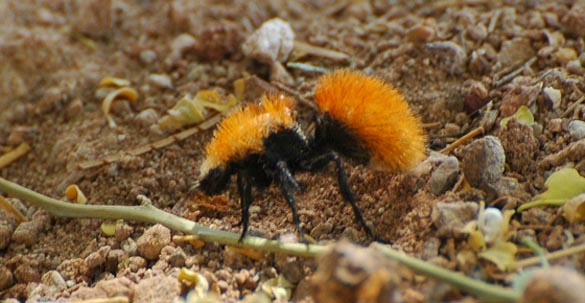
Female velvet ants are conspicuous on the surface of the ground during the day. Photo by Bob Wilkin. Bugguide.net
Velvet ants are not ants at all, but a specialized group of insects belonging to the wasp family Mutillidae. Mutillid wasps can be found in Texas during the summertime in both urban and rural habitats. They are often referred to as velvet ants because the females are wingless, ant-like and often covered with a velvety “fur”. Most kinds of velvet ants are black or brown and they may be strikingly ringed or marked with red, yellow or orange. They range in size from about one-half, to one inch-long and are frequently found outdoors in dry, open areas. Male mutillid wasps are winged and are more wasp-like in appearance.
Some of the larger species of velvet ants, such as Dasymutilla occidentalis, are occasionally referred to as “cow-killers” because of the painful sting that the female can inflict. This species and some others are capable of producing a “squeaking” sound when trapped or disturbed. Other species of velvet ants are also common in Texas, including the gray velvet ant and the thistle down mutillids, Dasymutilla beutenmulleri and D. fulvohirta.
Biology
Knowledge about the biology of velvet ants is limited, but those that have been studied are mostly parasites on ground-nesting bees and wasps. A few species are known to attack beetles and flies. Females spend much time in sandy areas searching for nests or aggregations of hosts. When a suitable host (e.g., a bee or wasp pupa) is found, the female lays one to two eggs inside its body. Upon hatching, the young feed on the host and devour it. Velvet ants spend the winter inside the nest of their hosts in a pre-adult (pre-pupal) stage. There is usually only one generation a year.
Medical Importance
People are most likely to receive a sting from a velvet ant when walking barefoot in infested areas, or by careless handling. The intensity of pain and reaction to the sting will vary according to the sensitivity of the person stung; however the sting is usually much more painful than a bee sting. Velvet ant stings should be cleaned and disinfected like a bee sting. Ice packs and pain-relievers should be applied as necessary. Because velvet ants usually travel alone and are not social, a person is unlikely to receive multiple stings. As with any stinging insect, if the sting victim experiences a generalized rash or difficulty breathing (signs of an allergic reaction) they should see a doctor immediately.
Control
Effective control measures for velvet ants are limited. The best steps for dealing with a velvet ant “problem” are 1) educating children not to handle these insects and 2) wearing proper footwear in infested areas. Velvet ants have very hard bodies and are difficult to crush.
For more information
For more information about other stinging insects refer to Extension fact sheets E-239, Paper Wasps, Yellowjackets and Solitary Wasps or E-346, Honey Bees In and Around Buildings. These publications, and help with additional questions about other pest problems, can be obtained by contacting your county Extension office.
Author:
Michael Merchant, Ph.D., Urban Entomologist, Texas AgriLife Extension Service